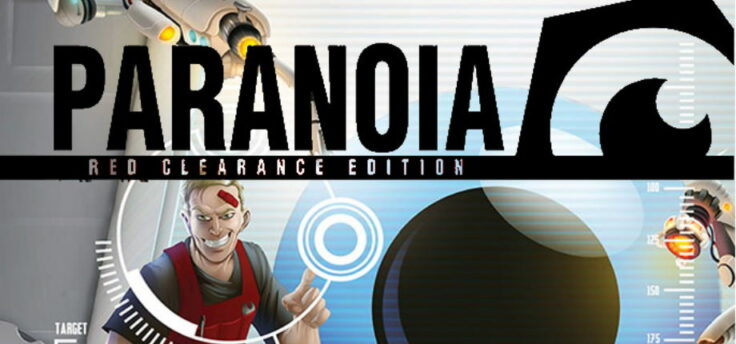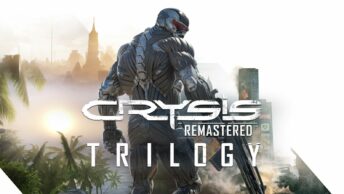Fun is mandatory
Mongoose Publishing
Genre: Tabletop RPG
Developer: Mongoose
Publisher: Mongoose
Release date: 14 April, 2017


Paranoia is a dark comedy RPG that’s shown remarkable staying power, despite how steeped in 80’s fears and pop culture the early editions of the game was. Released at the tail end of the red scare, Paranoia poked fun at the fears of the 80’s, where parents told their children to check under their bed for evil communists. Parents don’t tell their kids to check for communists under their beds anymore, but they do tell them to check for terrorists.
Paranoia has adapted to the changing times. It’s still a game that pokes fun at people’s irrational fears, and also a bit at pop culture, and RPGs in general, but all of these things have changed since the first edition of Paranoia was released, back in 1984. But how well does the latest iteration of this classic RPG series play?
The Paranoia: Red Clearance edition is a boxed game that comes with three booklets, one being a player’s guide, one a gm’s guide and the last a set of three intro adventures (as well as an additional classic short one), 110 playing cards, five dice and some character sheets.

The Setting
The year is 214. Last year was also 214, and the next year will be 214. How long as it been 214? Nobody really knows, in fact nobody can remember it ever being any other year. Mankind has been forced into living in a huge probably underground bunker complex called “Alpha complex”, ruled over by a benevolent computer. The computer is your friend, and only wants what’s best for you.
Messy things like procreation through natural means is no longer a thing in Alpha Complex, everyone is a clone. People are grown in large vats, and cloned in groups of six, each one being identical to the other members of their clone family. Clones are created as fully formed adults, with memories implanted in their brains that make them know the ins and outs of alpha complex, except of course for when they’re created as children and/or when they are not created with these memories.
Alpha Complex is a strictly hierarchical society. Newborn clone families find themselves at the bottom of the food chain, and those who show initiative, loyalty and the ability to pin the blame onto others usually are able to advance up the ranks. A characters rank is denoted by colour, with infrared and red being at the bottom, and violet and ultraviolet at the top. Remember (i)roy-g-biv(u) and you’ll be fine in Alpha Complex. Well, fine might not be the right word, but you’ll avoid some embarrassing situations and accusations of treason at least. Anyone of a higher rank pretty much has free reign to order those of lower rank around, and nobody will believe someone of a lower rank who are accusing someone of a higher rank, unless they can present ample evidence.
Ruling over all of Alpha Complex is of course friend computer. Friend computer really does want what’s best for you, and tries to be helpful and supportive to all loyal clones of Alpha Complex. The problem is that Friend Computer has been running for as long as Alpha Complex has existed, since the fabled year 0, and is starting to wear down. This has left Friend Computer paranoid, and it believes that there are traitors and terrorists everywhere. And worst of all are DAIVS, though information on who or what DAIVS might be is probably above your security clearance. If a clone is in trouble, Friend Computer is likely to try and intervene in a helpful way, maybe by saying something motivating across the speakers as the clone is trying to sneak up on some terrorists, or blur out the yucky blood when someone is performing surgery. Friend computer only does this because it really does want what’s best for you.

Even though Friend Computer is paranoid, there really are elements within Alpha Complex that wants to see society collapse, and be replaced by something more to the liking of those people. Secret societies come in several different flavours, from the ultra-capitalist Free Enterprise, to the Communists. Heck, some of these societies might not even try to overthrow Friend Computer, but need to operate in secret for one reason or another, like the First Church of Christ Computer Programmers (or FCCCP for short (that acronym probably worked better in the 80’s)).
The player characters are likely to be playing troubleshooters, that is people who shoot those causing trouble (and maybe also fix some of the issues caused by that trouble, but only if they’re lucky). Troubleshooters serve a special role in Alpha Complex and are usually spared menial jobs, like scrubbing the vending machines and keeping the food vats from becoming sentient, and are even given a degree of freedom, and all for the low low price of constantly risking their lives fighting terrorists, traitors and whatever came out of the food vat when it became sentient.
The setting in paranoia is in other words what would happen if you were to take the most extreme elements from Brave New World and 1984 and mix them together, while also adding a dash of present day fears, and some absurdist humor. The setting is entertaining and the descriptions of it well written, though the GM’s guide could have used more information about life in Alpha Complex.
The Player Characters
The player characters are of course clones in Alpha Complex, usually starting as “red” clearance citizens, though depending on the campaign that does not necessarily have to be the case. Even at character creation players are given the chance to screw each other over, as Paranoia has a rather unique way of creating new characters.

The first thing the group does is assigning skills. There are 16 different skills in the game, which includes things like guns, bureaucracy (a vital skill for those who wants to avoid treason) and charm, and by the end of character creation five of these will have positive values, and five negative values. Starting with a fitting player they’ll pick a skill and put a +1 in it, the player to their left then gets a -1 in that skill. That player then does the same, until you’ve gone full circle. Then the process is repeated with a +/- 2 in a skill that’s currently at a 0 and keep repeating this until you’ve got a skill with a +5 and a skill with a -5. The skills are grouped together in four different groups, corresponding to a stat, and you now add up the number of positive skill in each group. If you say have 2 positive and 2 negative skills in “brains” that’s still a 2. If you have 0 positives and 3 negative in violence , that’s a 0. You now have four numbers, ranging from 0 to 4, which can be allocated to your stats, but not by you, but rather the player you sent all those negative numbers to.
That’s almost it for character creation. Every character starts with 8 points of moxie (which determines how well you’re holding together under stress) and 6 clones. You can permanently sacrifice both moxie and clones in order to improve your stats and skills. Paranoia is a lethal game, and those clones are basically extra lives, so sacrificing too many is likely to make you have to roll up a new character within a session or two. There are rules for creating a character on your own, though they’re not as fun.
Being in a secret society, and being a mutant both counts as treason. A mutant might register their powers, though then they’ll not be trusted by anyone, so many choose not to do it. Of course most players will both be mutants and members of secret societies (and they’ll rarely be members of the same secret society). Every character gets a random mutant power and secret society assigned to them when they’re created. There are cards for both mutant powers and secret societies, which contains the rules for these. Mutant powers involve the ability to be able to turn invisible, levitate or make machines (other than the computer) really like you. The last one can never be registered, and people who are found to have it tend to soon thereafter not be found anymore.
Character advancement is done through XP. Nobody knows what XP stands for, but as credits obviously never existed and thinking that credits did exist is treason, XP is the universal currency in Alpha Complex. When you do things that the computer likes, like exposing traitors, killing traitors or making sure that traitors get killed you’ll earn XP. This is then used to buy stuff, be it higher security clearance, new clones, better stats or soda.
The Rules
Paranoia is a game that plays it pretty fast and loose with its rules. Don’t go into Paranoia expecting a rigid and tactical rulelset like D&D or Pathfinder, instead the rules in Paranoia are meant to be fast (and promote people to shoot each other in the back).

At its core Paranoia uses a pretty simple dice pool system. When performing a skill check you take your stat + skill, and roll that many dice. Any die that comes up a 5 or a 6 is a success, and the GM decides how many successes is needed in order for an action to succeed. Whenever you’re making a dice roll you’re also rolling one very special die, that needs to stand out from the rest, called the “computer dice” (why is the computer dice in plural? According to the rulebook it’s because the word “die” would get used too much in Paranoia otherwise). If the computer dice comes up a six then the computer has decided to intervene in a “helpful” way, or something else has gone wrong, which will be up to the GM to decide. If you end up having to roll a negative number of dice (as skills can be negative) you’re still allowed to roll, but now any unsuccessful dice counts as negative successes. It’s simple and works well in action.
Your moxie allows you to perform better when needed, or use your mutant powers that you’ve obviously registered. One point of moxie lets you add another die to a roll, re-roll a failed roll or active one of your powers. Rolling a six on the computer die will on the other hand cost you a point of moxie, as it can be rather stressful when the computer intervenes as inopportune moments (particularly as telling the computer that it is an inopportune moment is treason, so you can’t ask the computer to leave you alone). If moxie reaches 0 then your character is having a breakdown and fun (bad) things are likely to happen.
Combat will happen sooner or later, and the combat rules are fast and light. Performing a combat action is the same as performing any other skill. Combat is where the cards that came in the box comes in. Cards come in a few different variants, but the relevant ones here are the action cards, mutant powers and equipment cards. Players will usually start a game with one equipment card and four action cards, and at the start of a combat round players play one of their cards face down. These cards will have an effect as well as an initiative order listed on them. Then when it’s your turn in the initiative order you get to act. Note that the card is played face down, so you can lie about when it’s your turn, though other players are allowed to call your lie. If it turns out that you did lie you lose your round, and whoever called your bluff gets to act immediately (they also get to act when it’s their turn), but if it turns out that you were honest, they lose an action card. Once it’s time to perform an action you then chose if you want to play your card, or pick it back up again and do something boring like just shooting the enemy. Action cards are pretty varied, and many of them requires the player to describe how the action fits it. For an example the card “improvised defense” , which has the player find something that they can use to protect themselves, like using a piece of a broken bot as an improvised helmet or “up high” which lets the player somehow find an elevated position which gives them a bonus on their actions. The cards are part narrative devices, part things that give player characters a rules advantage.
If you hit someone in combat they’re likely to be injured (unless they have armour that can prevent all the damage). Any additional successes adds to the damage, and once a character has taken four points of damage, they’re dead. No death saves or any such silliness here, they’re just plain dead. Remember that everyone is part of a clone family of 6, so if a character dies they’ll get a replacement. The replacement character will be delivered at the first opportune moment, and they’ll conveniently have all the memories of their old character, except for the moments leading up to their death (so they’re not allowed to just retaliate against someone who just killed them).

Everyone clone is at all time connected to Alpha Complex through their “cerebral coretech”. This gives the characters information about everyone around them, including their names, how suspected of treason they are, and so on, as well as the ability to get the information needed to navigate through Alpha Complex. That is, unless they’re in one of the many dead zones. In effect the players basically get most of the relevant information about someone by just looking at them. If someone commits treason, and the computer is made aware of it, a star will appear over their head. The more stars are there, the more treasonous the person is suspected to be. A single star is not too bad, though you might want to keep an eye on them, five stars means that the computer will reward you with a lot of sweet XP if you deal with them. This includes other player characters. In fact it should quite often include other player characters. Think videogame HUD and you have a pretty good idea of what the “cerebral coretech” makes the world look like for most people.
New clones are considered blank slates in terms of treason. Even though they probably have the exact same mutant powers and affiliations as the last one they’re treated as being loyal citizens by the computer, and so you’re not allowed to harm them until they’ve actually done something bad. Paranoia would not really work if you treat every new clone as just as treasonous as the old one, even though it would make logical sense.
The rules in Paranoia are simple and straight forward, but they work well for this kind of game. Paranoia is not a game that would have benefited from having a lot of complex rules. The cards takes a little bit of getting used to, but after a session or two they feel like second nature.
The Included Adventures
There are three main adventures in the adventure booklet that are meant to introduce both the players and the GM to the game, as well as the setting. The adventures are short, the estimate given for their length is about 2-3h each, though for some groups (like mine) they’ll probably be more like 3-4h. Still, they’re single session adventures that are easy to run.
The first adventure is likely to drive an experienced GM nuts, as it’s written with the assumption that you’ve never played an RPG before, and is very, very handholdey. The other two adventures are more open, both for the GM and the players. None of the included adventures are spectacular, but the last of the three is probably the best. The last adventure, which is not part of the main linked ones, is probably the best of the lot, if for no other reason than how it highlights the absurdities of alpha complex rather effectively.
Art, Layout & Quality
Here we come to what’s probably the weakest point of Paranoia, the art. The art on both the cards and the rulebook is full colour and feel consistent, but it’s not as well drawn as the art in many other current RPGs. There are some funny images, particularly on the cards, but it feels closer to the kind of art we would have got in an RPG from a smaller publisher 20 years ago than a current RPG. There’s also not a lot of art that’s used to flesh out the setting, most of it just shows entertaining situations. This is an area where older editions of Paranoia generally was better.

There’s a table of content, but no index, in the books. Had the booklets been longer this would have been an issue, but as they are so short it’s pretty easy to find what you’re looking for, and with how the game is written you rarely need to look up rules anyway. The layout is also pretty decent, and befitting a comedy RPG space is given for silly jokes.
The booklets seem to be printed on good paper and the print quality is also overall good. These are softcover books with glued binding though, so how well they’ll handle repeated use is going to be interesting to see, but they feel pretty sturdy for what they are. The cards needs sleeves though, as they’re printed on pretty thin cardstock, the kind that will wear out pretty fast.
Finally there are the character sheets, which are dry-erase. That’s very on-brand for Paranoia and that alone should give you an idea of how long player characters are expected to actually live. How long they’ll last is hard to tell, but after a bit of testing they seem to wipe off easily. This might be a problem if you actually intend to keep characters between sessions.
Closing Thoughts
The latest edition of Paranoia is a blast to play. It does require both the GM and the players to go in with a certain mindset though. For the players they need to be able to bring out their competitive side, and be willing to shoot each other in the back, while for the GM needs to be willing to put players in really awkward situations with no proper solution. Players have extra lives in Paranoia for a reason. The GM should not actively try to kill player characters though, but rather find ways to make the players squirm a bit.
I would have liked to see some more space dedicated to worldbuilding, as this is something I feel older editions (or at least the edition I’m most familiar with, 2nd edition) did better. That said, that’s one of the few things (well, apart from some of the art) that I think the older editions actually did better than the new edition. What makes the Red Clearance edition really shine is how they’ve managed to find mechanical incentives for players to screw each other over, and this is ultimately where a lot of the games comedy comes from, as players try to find inventive ways of pining the blame on each other and making sure that the other players seem like the “bad guys” (after all, if you can make your fellow other player into a traitor, that’s free XP if you kill them!)
Paranoia is a game that plays quite differently from pretty much any other RPG out there, and it’s not for everyone, but it’s a great RPG to play as a palate cleanser between other RPGs, or just for when you want to play something different. Also, despite its reputation, it’s not actually terrible for campaign play. Other games might have better support for longer campaigns, but Paranoia: Red Clearance Edition would work well for at least a shorter campaign.










